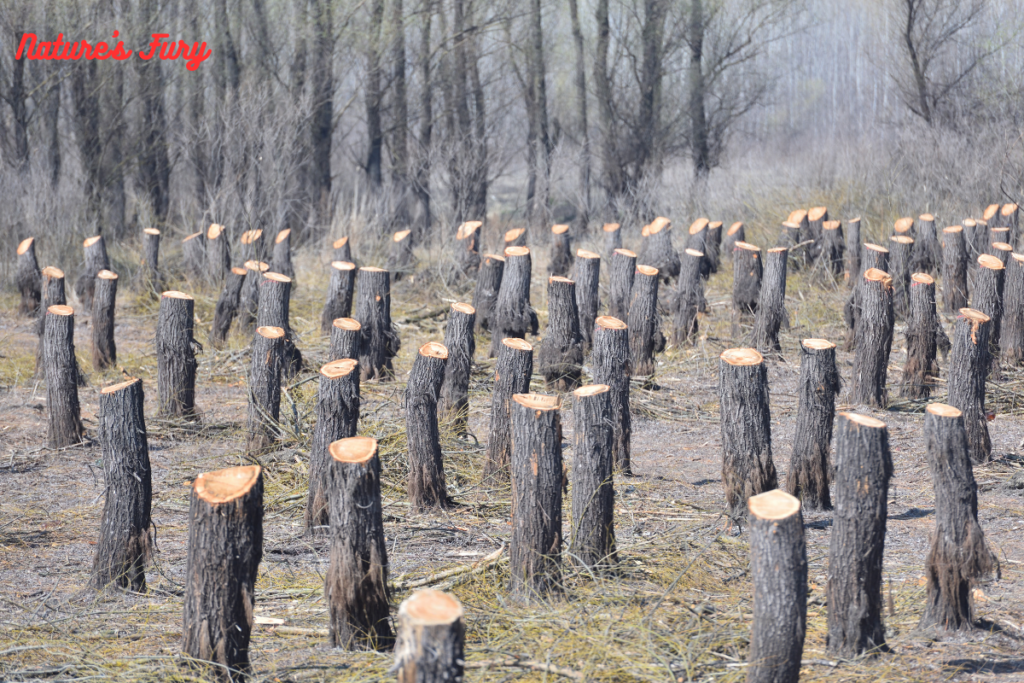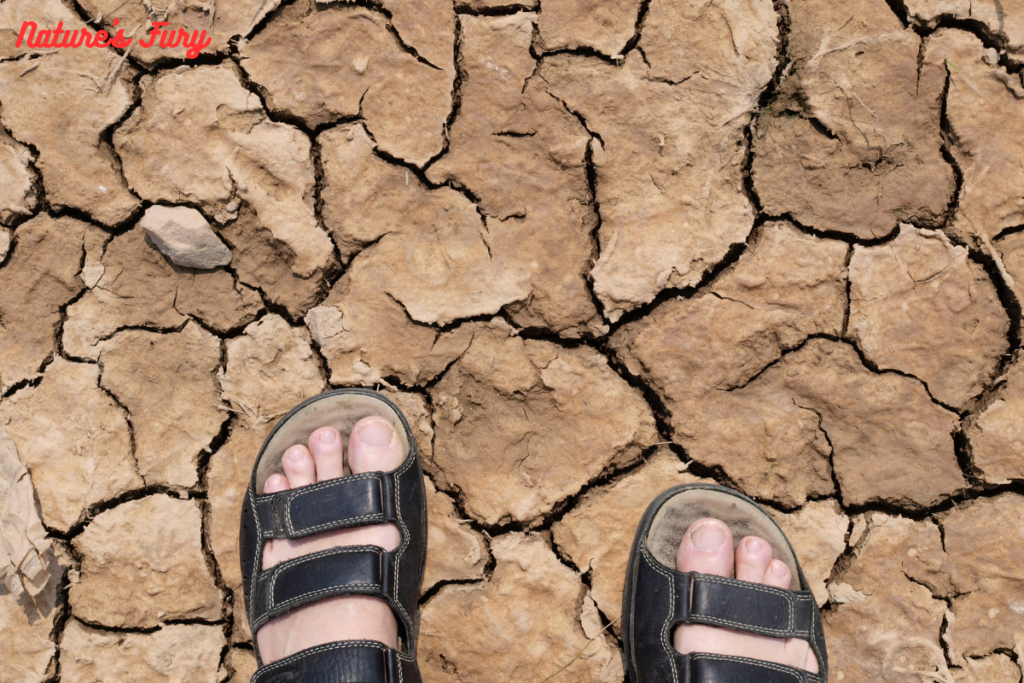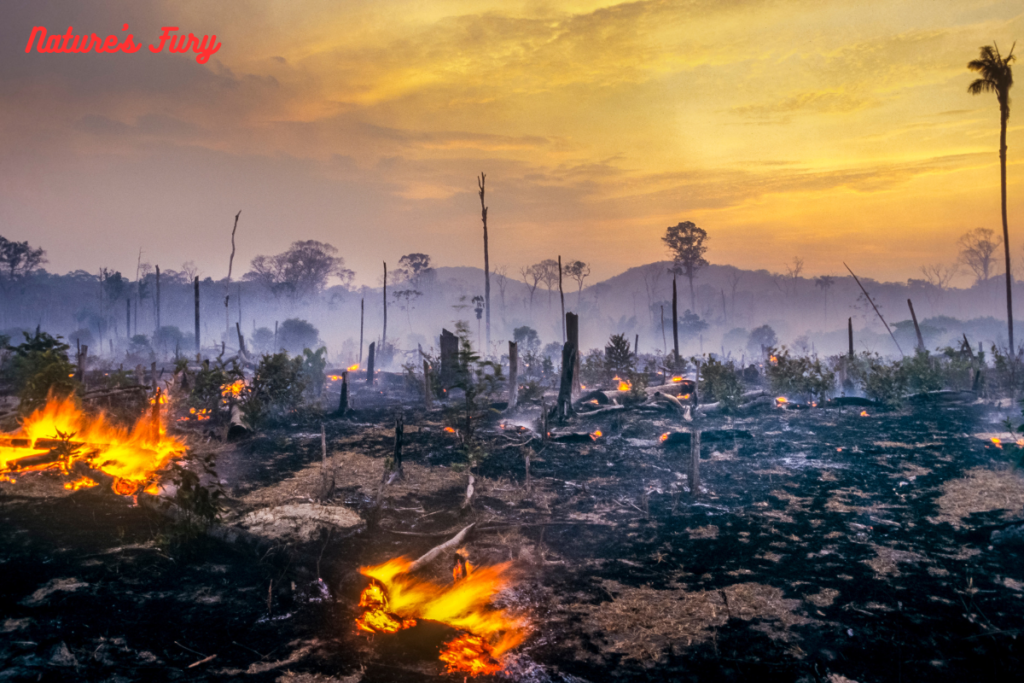Introduction:

“Nature’s Fury” informs us of our earth’s strong forces and the results of our activities. Over the past century, humanity’s unrelenting quest for industrial development and urban growth has upset natural ecosystems and added to environmental imbalance. Driven by greenhouse gas emissions from many human activities, climate change has sharpened weather patterns and set off devastating catastrophes such as floods, storms, and wildfires. Understanding the link between our contemporary lives and the unrestrained force of “Nature’s Fury” becomes essential as we stand on the brink of an environmental calamity.
Moreover, the rising frequency and intensity of natural disasters draw attention to a great need for introspection and preventive actions. The phrase “nature’s fury” reminds us of the resiliency of nature itself in addition to capturing the devastation these occurrences cause.
Acknowledging our part in aggravating these problems would help us to pursue sustainable practices that safeguard the environment, slow down global warming, and eventually balance human life with the surroundings. Accepting this change will help us to live in a time when we value and cohabit peacefully with the strong yet beautiful powers of nature forming our world, which is vividly explored in “Natural Disasters: Nature’s Fury“.
Table of Contents
Understanding the Cause:
Recent years have seen growing clear evidence of how human activity fuels the rise in natural disaster frequency. Given the range of extreme weather occurrences our world experiences, it is imperative to explore the ways we have driven this issue. Examining the fundamental causes—especially how our industrial activities, urban growth, and resource consumption have aggravated “Nature’s Fury”—helps us to realise our involvement in this growing phenomena.
Human Impact on Climate:

The planet’s temperature has been drastically changed by the increase in greenhouse gas emissions from transportation, energy generation, and industry operations. Burning fossil fuels at an alarming pace causes the resultant pollutants to trap heat in the atmosphere, hence causing global warming. Along with temperature, this warming alters weather patterns and increases the frequency and intensity of events including storms, hurricanes, and protracted drenches. In this regard, “Nature’s Fury” reminds us sharply of the results of human activities: when the surroundings is disturbed, it no longer operates in harmony and generates disastrous natural events.
Deforestation and Land Use:
Another crucial factor in how humans have driven “Nature’s Fury” is our unrelenting quest of development and altered land use, especially with relation to deforestation. Along with depriving the planet of its essential green cover, removing forests for mining, urban growth, and agriculture has upset nearby ecosystems. Because trees are so important for water retention and soil stability, this loss of biodiversity and natural buffers increases the vulnerability of areas to the consequences of extreme weather. Thus, when a disaster strikes, the resultant flooding, erosion, and fires can be linked to human actions that give short-term benefit above long-term environmental sustainability.
Resource Consumption and Waste:
Furthermore aggravating “Nature’s Fury” are our patterns of waste generation and resource consumption; the great stress the Earth suffers from the overuse of natural resources such water, minerals, and fossil fuels. Plastic pollution and landfill overflow among other waste management problems help to degrade the ecosystem and impede nature’s capacity for catastrophe recovery. We not only harm our ecosystems but also magnify the consequences of natural disasters as we keep generating trash without sustainable control. Thus, realising our part in enabling “Nature’s Fury” will help us to steer towards more ethical and ecological living for the next generations.
Climate Change Connection:

A serious problem with worldwide attention in recent years is the connection between climate change and severe weather patterns. Understanding this link helps one to appreciate the wider consequences of climate change on our environment and society. The frequency and intensity of natural disasters have surged as the temperature continues to warm thanks to human-induced activities.
Changing Weather Patterns:
Significant changes in global weather patterns brought about by climate change directly support even more violent storm events. More violent rain and flooding follow from the increasing capacity of the atmosphere to retain moisture as temperatures rise. Furthermore, more strong hurricanes and typhoons driven by warmer ocean waters cause more damage upon landing. In this regard, “Nature’s Fury” shows up as these severe storms that affect ecosystems, towns, and businesses, sometimes leaving devastation in their wake.
The Feedback Loop:
The feedback loop formed by “Nature’s Fury” and climate change is one of the concerning features of this relationship. By spewing stored carbon dioxide and methane into the atmosphere, natural calamities can aggravate climate change; consider wildfires consuming forests or thawing permafrost generating greenhouse gases. These emissions hasten global warming and set a loop whereby the very events brought on by climate change magnify their consequences. Every event of “Nature’s Fury” therefore emphasises the need of tackling climate change and stopping the cycle of destruction endangering our world.
Impact on Vulnerable Communities:
The effects of “Nature’s Fury” and climate change most affect underprivileged areas, therefore highlighting social inequalities in disaster response and recovery. Often living in disaster-prone regions, low-income populations and underprivileged groups have less means to get ready for and bounce back from major storms. These people suffer terrible consequences—loss of homes, livelihoods, and access to basic services—as well as the weight of climate-related issues. Emphasising this link highlights the need of fair climate action and resilience planning so that, while we face “Nature’s Fury,” we also safeguard those most vulnerable.
Wildfire Incidence:

Rising frequency of wildfires in recent years emphasises a crucial environmental problem interacting with human activities. Understanding the contributing causes will enable us to find ways to minimise the terrible side of “Nature’s Fury,” as deforestation and poor land management cause major changes in forests and natural settings, so increasing the frequency and intensity of wildfires.
Deforestation and Habitat Loss:
Deforestation for urban development, logging, and agriculture eliminates essential flora meant to help stop wildfires from spreading. In addition to providing a barrier, trees and plants assist to preserve soil moisture and stability.
Areas become more prone to ignite and fast fire spread when these natural firebreaks are destroyed. Deforestation thus enhances ‘Nature’s Fury,’ resulting in bigger and more uncontrollable wildfires that damage ecosystems, wildlife, and communities both equally, highlighting “Our Role in the Disasters We Face: A Call for Action“.
Land Mismanagement Practices:
Moreover greatly aggravating the frequency of wildfires is inadequate land management methods. Many times, improper management and fire control techniques cause uncontrolled brush and undergrowth to build in forested regions. Under ideal conditions—that is, dry weather, high temperatures, and strong winds—these fuel loads become very flammable, increasing the likelihood of wildfires. Mismanagement therefore transforms the terrain into a tinderbox, which fuels the destructive character of “Nature’s Fury,” and tests emergency services and firemen to contain ever more intense flames.
Climate Change Influence:
Rising global temperatures and altered precipitation patterns produce conditions more favourable for wildfires, therefore intensifying the degree of “Nature’s Fury” in relation to climate change. While droughs produce dry environments that could ignite readily, heat waves raise the risk of ignition and fast fire spread. Thus, we will see a recurring cycle of destruction as long as the contributing elements of land mismanagement, deforestation, and climate change remain uncontrolled, so underscoring the importance of quick action to solve these effects on “Nature’s Fury.”
Ecosystem Disruption:
Urbanisation and pollution have major effects on ecosystems, changing natural habitats and causing disturbances that could show up in unanticipated and catastrophic forms. Understanding these effects can help us to create plans that safeguard and conserve the important ecosystems of our planet as cities grow and pollution levels rise disturb the equilibrium of ecosystems, therefore intensifying the degree and unpredictability of “Nature’s Fury.”
Impact of Urbanization on Natural Habitats:
Urban regions’ explosive expansion sometimes results in the destruction of natural settings since development takes place by clearing wetlands, forests, and other ecosystems. This invasion disturbs habitat and drives out species, therefore lowering biodiversity and changing ecological dynamics. Consequently, the inherent defences against disasters that ecosystems offer—such as soil stabilisation and water absorption—are undermined. Under these circumstances, “Nature’s Fury” becomes more erratic, metropolitan areas suffering more flooding, erosion, and other kinds of environmental damage.
Pollution and Ecosystem Health:

Another important disturbance of ecosystem health is pollution, which in several respects fuels “Nature’s Fury”. Harmful chemicals brought into the environment by air and water pollution from waste disposal, industrial activity, and agricultural runoff compromise the health and resilience of plants and animals. Particularly aquatic ecosystems suffer from pollution; rivers becoming contaminated and less able to control floods and storms. The deterioration of these natural processes implies that the environment is less able to minimise damage when calamities strike, therefore intensifying the destructive power of “Nature’s Fury.”
Cumulative Effects and Climate:
Urban areas often act as heat islands, raising local temperatures and changing local weather patterns, therefore contributing to more general climate changes that aggravate “Nature’s Fury.” Pollution often has such consequences. These elements, together with global climate change, produce more frequent and severe storms. Apart from causing immediate environmental problems, the disturbances in local ecosystems brought about by human activities feed into more general climate events, hence generating a cycle of harmful natural disasters. Dealing with these problems calls for dedicated efforts to lower pollution, control urban development sustainably, and rebuild ecosystems to counter “Nature’s Fury.”
Resilience of Nature:
The natural world shows an amazing capacity for resilience and recovery even with the destruction caused by natural disasters and human-induced disturbances. In “Nature’s Fury,” this amazing capacity for healing and regeneration creates a conundrum as, although these energies can be destructive, they also support the natural cycle of renewal and balance. Knowing this resilience will help us to develop a more harmonic coexistence with the surroundings.
Natural Regeneration and Recovery:
Whether from wildfires, hurricanes, or human activity, ecosystems all around have an intrinsic potential to rebuild following disturbances. Forests regenerate, wetlands heal themselves, and over time wildlife numbers recover to show the resiliency of nature. This natural ability to heal is evidence of the complex equilibrium that exists in ecosystems despite the sporadic expression of “Nature’s Fury.” It reflects how natural systems are made to withstand and recover from disturbances, so guaranteeing the continuity of life even in the aftermath of major environmental events.
Role of Natural Disturbances:
Ironically, preserving ecological balance depends much on natural disruptions themselves. For example, floods can increase soil fertility while wildfires assist regenerate forests by removing old foliage and letting fresh plants flourish. Though apparently harmful, these acts of “nature’s fury” are vital for the vitality of ecosystems. This point of view emphasises the need of seeing natural disasters as essential components of ecological processes promoting biodiversity and environmental stability rather than only as hazards.
Learning from Nature's Resilience:
Acknowledging and appreciating the resiliency of nature teaches human civilisations a lot. It motivates us to follow methods that fit the cycles of the natural world, including efforts at conservation and sustainable land management. Let nature the time and space it needs to heal so that, even if strong, “Nature’s Fury” stays a force that supports rather than destroys. By embracing this balance, we can show how humans might cohabit sustainably with the strong resilience of the natural world and move towards a future whereby human prosperity and environmental health are mutually supporting.
Mitigation Strategies:

Adopting sustainable practices and policies will help to reduce the human influence on the surroundings and stop additional aggravation of “Nature’s Fury.” These approaches centre on lowering emissions, preserving natural resources, and putting aggressive policies into existence that assist to slow down environmental damage and climate change effects. Adopting these strategies will help us to lower our involvement in natural disasters and advance a more sustainable equilibrium with the earth.
Renewable Energy and Emission Reduction:
Changing from fossil fuels to renewable energy sources like solar, wind, and hydroelectric electricity is one of the most efficient approaches to lessen human damage on the environment. Apart from adopting greener energy, stricter emission rules and incentivising carbon capture technologies can help to further minimise our environmental impact and greatly lower greenhouse gas emissions, which are main causes of climate change and, hence, “Nature’s Fury.” These steps help to slow down global warming, hence lowering the frequency and strength of severe storms.
Conservation and Sustainable Land Management:
Reducing the effect of human activity on natural environments mostly depends on using sustainable land management techniques and conserving methods. Preserving wetlands, forests, and other important habitats supports biodiversity and ecosystem services—which function as natural disaster buffers. Reforestation, integrated water management, and sustainable agriculture can help to restore degraded landscapes and lower the possibility of destructive expressions of “Nature’s Fury.” Urban design including green areas and natural buffers can also improve resilience against flooding and storms.
Policy and Community Engagement:
Good mitigation calls for robust policies and community involvement. Governments and businesses have to cooperate to develop and implement environmental policies encouraging resilience and sustainability. This covers establishing high-minded climate targets, fostering sustainable technology research and development, and funding catastrophe readiness and response mechanisms. Equally crucial is involving communities at all levels to support sustainable living and conservation initiatives so reducing the load of “Nature’s Fury” by group action and responsibility. Encouragement of people and groups to participate in mitigating plans helps to create a shared dedication to preserve the surroundings and create a sustainable future.
Community Preparedness:

The need of community preparedness cannot be emphasised as natural catastrophes get more common and severe. By means of proactive education and resource management, local communities significantly help to lower the hazards related with “Nature’s Fury”. Resilience may be greatly improved by arming people and businesses with the information and instruments needed to react properly to natural disasters, therefore protecting life and property.
Education and Awareness Programs:
Education is basic in preparing communities for the unpredictable events related with “Nature’s Fury.” By giving inhabitants correct knowledge on the kinds of natural catastrophes they may experience, as well as the possible repercussions, communities may build a culture of readiness and resilience. Public awareness programs, simulations, and seminars can provide people first aid, evacuation planning, and emergency communication abilities. Equipped with information and expertise, communities are more suited to respond swiftly and forcefully when a disaster strikes, therefore reducing damage and enabling a faster rehabilitation.
Resource Management and Infrastructure:
Reducing the consequences of natural disasters depends critically on effective resource management. Local governments and businesses have to make sure that, in times of disaster, important resources—food, water, medical supplies, and shelter—are easily accessible and plentiful. Equally vital is funding strong infrastructure capable of withstanding “Nature’s Fury”. This covers maintaining emergency response systems, bolstering buildings, and creating flood defences. Communities can lower their susceptibility and improve their capacity to withstand and rebuild from disasters by foreseeing needs and designing accordingly.
Community Engagement and Collaboration:
When community preparedness entails cooperation among neighbours, local government, and businesses, it is most successful. Including communities in disaster preparation not only strengthens local networks but also promotes group responsibility of preparedness initiatives. To simplify reaction plans, community leaders can plan exercises and communicate with emergency services. Encouragement of volunteers and local response teams can also help to build a strong community framework ready to meet “Nature’s Fury.” Working together, communities can maximise their combined resources and guarantee that, should a disaster strike, they can react with agility and harmony.
Policy and Advocacy:
Dealing with the underlying causes of environmental damage and climate change calls for national and worldwide strong policy and advocacy campaigns. Reducing “Nature’s Fury” and guaranteeing a sustainable future depend on government action as well as worldwide collaboration. Implementing thorough environmental policies and supporting worldwide alliances can let us all contribute to lower the effect of natural disasters and support environmental resilience.
National Policy Implementation:
By implementing robust domestic policies that give sustainability and environmental protection top priority, governments should lead in combating climate change. This covers creating rules to lower greenhouse gas emissions, funding projects involving renewable energy, and running conservation programs. Setting ambitious environmental goals and ensuring their integration across many spheres of the economy will help national policies greatly lower the human activities driving “Nature’s Fury.” Moreover, incentives for companies and people to adopt sustainable practices will help society move towards a greener and more resilient future.
Global Cooperation and Agreements:
Global and across national boundaries, climate change calls for international cooperation. Aligning efforts to combat “Nature’s Fury” depends on cooperative efforts including global climate agreements and multinational environmental coalitions; international forums like the United Nations Climate Change Conferences help nations to communicate and commit themselves to lower emissions and support climate adaptation strategies. By means of cooperation and shared responsibility, nations may maximise resources, distribute technological innovations, and create coordinated responses to lessen the effect of natural disasters aggravuated by climate change.
Advocacy and Grassroots Movements:
Effective policy and global cooperation depend much on grassroots movements pushing government will and public awareness. Emphasising the need of tackling climate change and gathering public support for legislative proposals, environmental advocacy groups and grassroots organisations are rather important. These movements help hold leaders responsible by involving people, increasing awareness, and advocating open government so that addressing “Nature’s Fury” stays a top focus on the worldwide agenda. Promoting public involvement and action helps to create a vibrant civic environment that might drive significant legislative reforms and environmentally friendly living.
Future of Our Planet:
Encouragement of a forward-looking attitude that gives the health of our earth top priority is crucial as we consider the future. Understanding the force and unpredictability of “Nature’s Fury” and appreciating the delicate equilibrium existing in our surroundings helps one realise the urgency of this work. By means of creativity, knowledge, and environmentally friendly living, we can steer towards a more harmonic coexistence with the surroundings.
Innovative Solutions and Technologies:
Accepting technical developments and creativity offers a big chance to lessen environmental damage and effects of climate change. Advances in sustainable agriculture, waste management, and resource conservation will help us to live in harmony with the Earth’s ecosystems; developing and implementing clean energy technologies, such solar and wind power, can greatly lower our carbon footprint and help curb “Nature’s Fury.” Investing in research and encouraging innovation can help us to find fresh approaches to preserve our earth for next generations.
Education and Cultural Shift:
A sustainable future depends on people and societies learning the value of environmental stewardship. Education campaigns and awareness campaigns can enable individuals to make wise decisions helping the earth to remain healthy. Encouragement of conservation, energy efficiency, and responsible consumption becomes crucial in redefining society values to support long-term ecological health and resilience by means of a cultural shift towards sustainability, so cultivating respect for natural systems and reducing the activities intensifying “Nature’s Fury.”
Sustainable Development and Global Commitment:
A sustainable future calls for worldwide development committed to meeting human needs without endangering the health of the earth. This means reframing development to encompass ecological well-being and quality of life in addition to economic growth. Including environmental issues into policy-making and business operations guarantees that development initiatives do not aggravate “Nature’s Fury.” By giving sustainability top priority in social and economic planning, we can work for a world in which human activities improve rather than deplete the Earth’s natural resources, so guaranteeing a viable future for all living entities.
Conclusion:
As we have shown throughout “Nature’s Fury: How We Fueled the Fire,” our industrial activities, urban growth, and disrespect of ecological balance have increased the frequency and intensity of natural disasters, so intensuating the power and reach of “Nature’s Fury.” Our influence is evident from increasing greenhouse gas emissions causing climate change and erratic weather patterns to deforestation and poor land management allowing wildfires to occur. Still, this turbulent connection offers a possibility for transformation—a means to veer off course and minimise harm by adopting environmentally friendly policies and behaviours that complement the natural world.
The road forward calls for a shared awareness of our part in driving “Nature’s Fury,” and an equally cohesive will to undo these consequences. By means of creative technologies, thorough policy frameworks, and community involvement, we may start to bring about ecological equilibrium. Respecting the underlying force of “Nature’s Fury,” helps us not only safeguard our surroundings but also guarantee resilience for next generations. This road requires proactive local, national, and international cooperation as well as quick response to build a sustainable framework honouring the natural forces influencing our life. By doing this, we open the road for a harmonic and long-lasting relationship with the earth we live on.
People Also Ask:
How does "Nature's Fury: How We Fueled the Fire" help us understand the link between human activities and the intensification of natural disasters?
The documentary titled “Nature’s Fury: How We Fuelled the Fire” sheds light on the devastating effects of human activities like as deforestation and emissions, which exacerbate natural disasters by upsetting the delicate ecological balance.
What role does deforestation play in exacerbating nature's fury, as explored in the narrative?
Through the disruption of ecosystems, the reduction of rainfall absorption, and the increase in carbon emissions, deforestation hastens the wrath of nature, which in turn leads to the occurrence of extreme weather events and the loss of habitat.
In what ways can communities adapt to the challenges posed by nature's fury to build more resilient infrastructures?
An increase in resilience can be achieved by communities through the implementation of sustainable designs, the reinforcement of buildings, the prudent use of resources, and the incorporation of early warning systems for disaster preparedness.